 |
Members
Notes (2) |
 |
Members
Notes (2) |
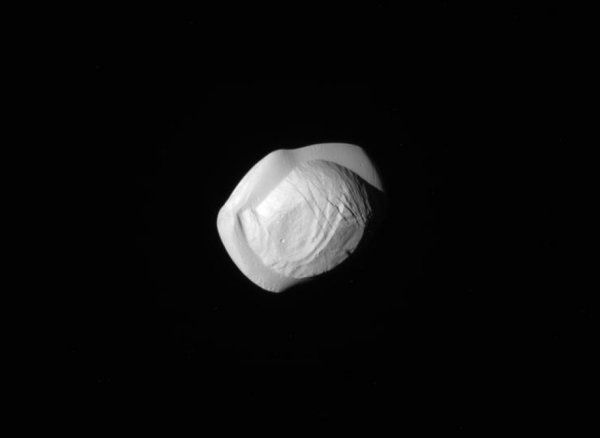 Saturn's strange moon Pan |
| Cassini Reveals Strange Shape of Saturn's Moon Pan |
|
Cassini's close
approach to Saturn's little moon Pan resulted in some images of a very
unusual moon within the rings. Ring scientists predicted Pan's existence
and location before it was discovered, and it was found in 1990 by examining
images that Voyager 2 had taken nearly a decade earlier. Up until now,
Cassini has been seeing Pan as a small bright speck within Saturn's
325-kilometer-wide Encke Gap in the A ring, where the little moon spends
its orbital life. This week, thanks to Cassini's ongoing series of ring-grazing
orbits, Pan joins the A-list of fascinating objects at Saturn. No matter
what earthly thing it may resemble, a walnut, a hat, or a flying saucer,
the scarred little ball of ice is definitely wearing a skirt. Obviously,
dust particles must have accreted there from within the Encke gap, forming
the tall snow-drift around its middle. Saturn's gravitation likely limits
the height of those dunes on the little moon. |
| Keyhole Nebula |
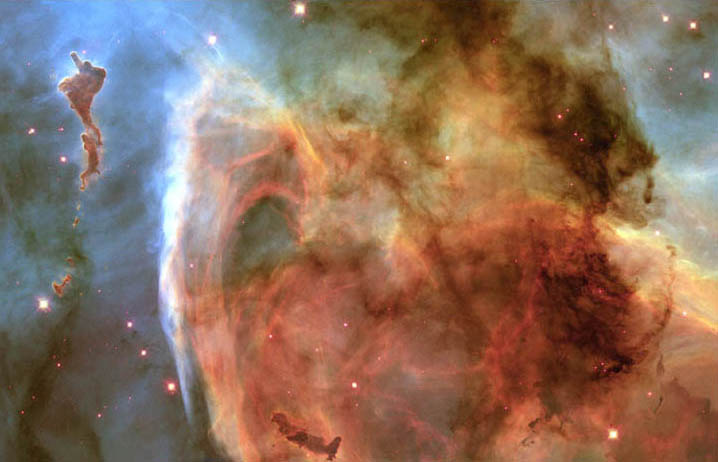 |
ABOUT
THIS IMAGE: The picture is dominated by a large, approximately circular feature, which is part of the Keyhole Nebula, named in the 19th century by Sir John Herschel. This region, about 8000 light-years from Earth, is located adjacent to the famous explosive variable star Eta Carinae, which lies just outside the field of view toward the upper right. The Carina Nebula also contains several other stars that are among the hottest and most massive known, each about 10 times as hot, and 100 times as massive, as our Sun. The circular Keyhole structure contains both bright filaments of hot, fluorescing gas, and dark silhouetted clouds of cold molecules and dust, all of which are in rapid, chaotic motion. The high resolution of the Hubble images reveals the relative three-dimensional locations of many of these features, as well as showing numerous small dark globules that may be in the process of collapsing to form new stars. Two striking large, sharp-edged dust clouds are located near the bottom center and upper left edges of the image. The former is immersed within the ring and the latter is just outside the ring. The pronounced pillars and knobs of the upper left cloud appear to point toward a luminous, massive star located just outside the field further toward the upper left, which may be responsible for illuminating and sculpting them by means of its high-energy radiation and stellar wind of high-velocity ejected material. These large dark clouds may eventually evaporate, or if there are sufficiently dense condensations within them, give birth to small star clusters. The Carina Nebula, with an overall diameter of more than 200 light-years, is one of the outstanding features of the Southern-Hemisphere portion of the Milky Way. The diameter of the Keyhole ring structure shown here is about 7 light-years. These data were collected by the Hubble Heritage Team and Nolan R. Walborn (STScI), Rodolfo H. Barba' (La Plata Observatory, Argentina), and Adeline Caulet (France). Object Names: Carina Nebula, C 3372 Image
Type: Astronomical |
| Big Mystery: Jupiter Looses a Stripe |
| Lost: A giant belt of brown clouds big enough to swallow Earth twenty times over. If found, please return to Jupiter. |
| May
20, 2010: In a development that has transformed the appearance of the solar system's
largest planet, one of Jupiter's two main cloud belts has completely disappeared.
"This is a big event," says planetary scientist Glenn Orton of NASA's Jet Propulsion Lab. "We're monitoring the situation closely and do not yet fully understand what's going on." |
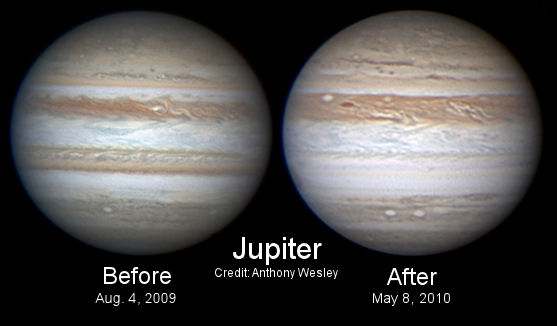 These side by side images of Jupiter taken by Australian astrophotographer Anthony Wesley show the SEB in August 2009, but not in May 2010.Individual images: Aug. 4, 2009; May 8, 2010 |
| Known
as the South Equatorial Belt (SEB), the brown cloudy band is twice as wide as
Earth and more than twenty times as long. The loss of such an enormous "stripe"
can be seen with ease halfway across the solar system. "In any size telescope, or even in large binoculars, Jupiter's signature appearance has always included two broad equatorial belts," says amateur astronomer Anthony Wesley of Australia. "I remember as a child seeing them through my small backyard refractor and it was unmistakable. Anyone who turns their telescope on Jupiter at the moment, however, will see a planet with only one belt--a very strange sight." Wesley is a veteran observer of Jupiter, famous for his discovery of a comet hitting the planet in 2009. Like many other astronomers, he noticed the belt fading late last year, "but I certainly didn't expect to see it completely disappear," he says. "Jupiter continues to surprise." Orton thinks the belt is not actually gone, but may be just hiding underneath some higher clouds. |
| "It's
possible," he hypothesizes, "that some 'ammonia cirrus' has formed on
top of the SEB, hiding the SEB from view." On Earth, white wispy cirrus clouds
are made of ice crystals. On Jupiter, the same sort of clouds can form, but the
crystals are made of ammonia (NH3) instead of water (H20). What would trigger such a broad outbreak of "ammonia cirrus"? Orton suspects that changes in global wind patterns have brought ammonia-rich material into the clear, cold zone above the SEB, setting the stage for formation of the high-altitude, icy clouds. "I'd love to send a probe in there to find out what's really going on." Indeed, Jupiter's atmosphere is a mysterious place which would benefit from exploration. No one knows, for instance, why the Great Red Spot is red—or what has sustained the raging storm for so many years. Neither does theory explain why the twin equatorial belts are brown, nor why one should vanish while the other remains. "We have a long list of questions," says Orton. This isn't the first time the SEB has faded out. "The SEB fades at irregular intervals, most | 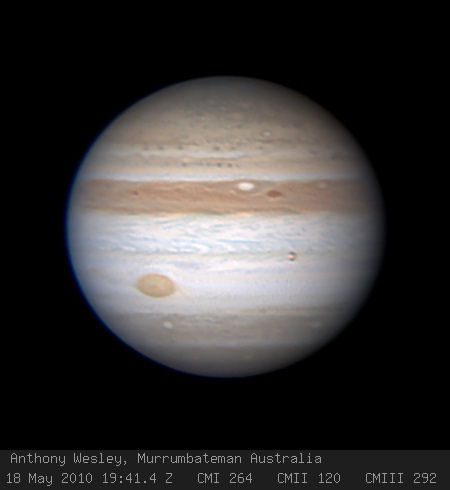 Without the SEB present, Jupiter's Great Red Spot is surrounded by almost uninterrupted white. Anthony Wesley took this picture on May 18, 2010 |
recently in 1973-75, 1989-90, 1993, 2007, 2010," says John Rogers, director of the British Astronomical Association's Jupiter Section. "The 2007 fading was terminated rather early, but in the other years the SEB was almost absent, as at present." The
return of the SEB can be dramatic. "I'll be watching every chance I get," says Wesley. "The revival will likely be sudden and dramatic, with planet-circling groups of storms appearing over the space of just a week or so." Indeed, says Orton, "anyone could be the first to spot the return of the SEB." Jupiter shines in the eastern sky before dawn at a 45º angle below and to the right of the head of Pisces. Point your optics at the "morning star" and … is that really Jupiter? Happy hunting! |
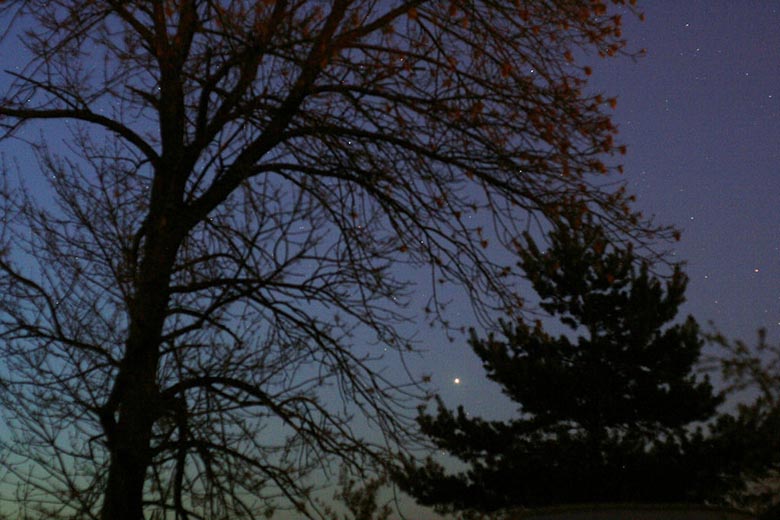 Jupiter
beckons to amateur astronomers from the pre-dawn sky. Lyle Anderson of Duluth,
Minnesota, took this picture on May 19, 2010. |
| Item submitted by Peter Struve 22 May 2010 - Courtesy of the NASA website |
| Saturn - The Co-Orbital Moons | |
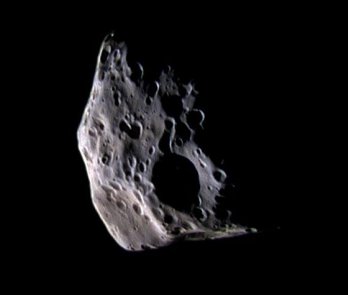 Epimetheus |
 Janus |
| The
Saturnian moons Janus and Epimetheus share their orbits, the difference
in semi-major axes being less than either's mean diameter. This means
the moon with the smaller semi-major axis will slowly catch up with the
other. As it does this, the moons gravitationally tug at each other, increasing
the semi-major axis of the moon that has caught up and decreasing that
of the other. This reverses their relative positions proportionally to
their masses and causes this process to begin anew with the moons' roles
reversed. In other words, they effectively swap orbits, ultimately oscillating
both about their mass-weighted mean orbit. Images courtesy of NASA/JPL Cassini Mission Submitted by Robin Wilkey - 30 March, 2017 |
|